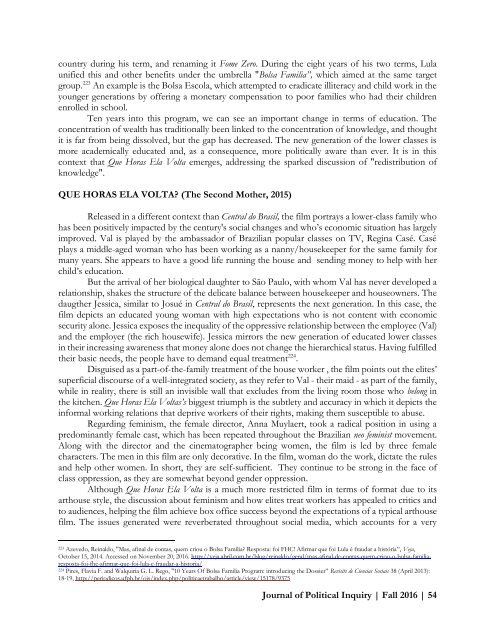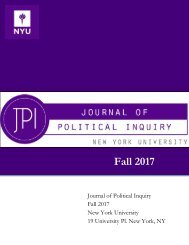Fall2016_Final2
You also want an ePaper? Increase the reach of your titles
YUMPU automatically turns print PDFs into web optimized ePapers that Google loves.
country during his term, and renaming it Fome Zero. During the eight years of his two terms, Lula<br />
unified this and other benefits under the umbrella "Bolsa Familia”, which aimed at the same target<br />
group. 223 An example is the Bolsa Escola, which attempted to eradicate illiteracy and child work in the<br />
younger generations by offering a monetary compensation to poor families who had their children<br />
enrolled in school.<br />
Ten years into this program, we can see an important change in terms of education. The<br />
concentration of wealth has traditionally been linked to the concentration of knowledge, and thought<br />
it is far from being dissolved, but the gap has decreased. The new generation of the lower classes is<br />
more academically educated and, as a consequence, more politically aware than ever. It is in this<br />
context that Que Horas Ela Volta emerges, addressing the sparked discussion of "redistribution of<br />
knowledge".<br />
QUE HORAS ELA VOLTA? (The Second Mother, 2015)<br />
Released in a different context than Central do Brasil, the film portrays a lower-class family who<br />
has been positively impacted by the century's social changes and who’s economic situation has largely<br />
improved. Val is played by the ambassador of Brazilian popular classes on TV, Regina Casé. Casé<br />
plays a middle-aged woman who has been working as a nanny/housekeeper for the same family for<br />
many years. She appears to have a good life running the house and sending money to help with her<br />
child’s education.<br />
But the arrival of her biological daughter to São Paulo, with whom Val has never developed a<br />
relationship, shakes the structure of the delicate balance between housekeeper and houseowners. The<br />
daugther Jessica, similar to Josué in Central do Brasil, represents the next generation. In this case, the<br />
film depicts an educated young woman with high expectations who is not content with economic<br />
security alone. Jessica exposes the inequality of the oppressive relationship between the employee (Val)<br />
and the employer (the rich housewife). Jessica mirrors the new generation of educated lower classes<br />
in their increasing awareness that money alone does not change the hierarchical status. Having fulfilled<br />
their basic needs, the people have to demand equal treatment 224 .<br />
Disguised as a part-of-the-family treatment of the house worker , the film points out the elites’<br />
superficial discourse of a well-integrated society, as they refer to Val - their maid - as part of the family,<br />
while in reality, there is still an invisible wall that excludes from the living room those who belong in<br />
the kitchen. Que Horas Ela Voltas’s biggest triumph is the subtlety and accuracy in which it depicts the<br />
informal working relations that deprive workers of their rights, making them susceptible to abuse.<br />
Regarding feminism, the female director, Anna Muylaert, took a radical position in using a<br />
predominantly female cast, which has been repeated throughout the Brazilian neo feminist movement.<br />
Along with the director and the cinematographer being women, the film is led by three female<br />
characters. The men in this film are only decorative. In the film, woman do the work, dictate the rules<br />
and help other women. In short, they are self-sufficient. They continue to be strong in the face of<br />
class oppression, as they are somewhat beyond gender oppression.<br />
Although Que Horas Ela Volta is a much more restricted film in terms of format due to its<br />
arthouse style, the discussion about feminism and how elites treat workers has appealed to critics and<br />
to audiences, helping the film achieve box office success beyond the expectations of a typical arthouse<br />
film. The issues generated were reverberated throughout social media, which accounts for a very<br />
223<br />
Azevedo, Reinaldo, "Mas, afinal de contas, quem criou o Bolsa Família? Resposta: foi FHC! Afirmar que foi Lula é fraudar a história”, Veja,<br />
October 15, 2014. Accessed on November 20, 2016. http://veja.abril.com.br/blog/reinaldo/geral/mas-afinal-de-contas-quem-criou-o-bolsa-familiaresposta-foi-fhc-afirmar-que-foi-lula-e-fraudar-a-historia/<br />
224<br />
Pires, Flavia F. and Walquiria G. L. Rego, "10 Years Of Bolsa Familia Program: introducing the Dossier” Revisits de Ciencias Sociais 38 (April 2013):<br />
18-19, http://periodicos.ufpb.br/ojs/index.php/politicaetrabalho/article/view/15178/9375<br />
Journal of Political Inquiry | Fall 2016 | 54
















